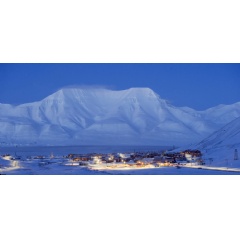Better avalanche warnings in the Arctic
Heavy snowfall in Europe this season has caused several severe avalanches, killing people and causing huge damage to infrastructure in Austria, Germany and Switzerland. Norway’s Arctic archipelago of Svalbard also went through avalanche evacuations due to the ongoing severe weather. Now, however, smart technology could help us stay prepared for avalanches, with the help of sensors in the snow.
“This project will improve regional avalanche warnings applicable to a larger area by providing verified snow coverage,” says Guttorm A. Hansen, Head of Telenor Svalbard.
This past month, more than 100 people were evacuated on Svalbard. Twenty-nine homes had to be abandoned and 80 students had to be moved out of their residences. The reason: storms and the risk of avalanches. Telenor is now initiating a pilot project in which technology will provide better indications of avalanche risks, enhancing both preparedness and safety amongst the local population in the long-term.
Measuring avalanche riskIn 2015 and 2016, large avalanches hit Longyearbyen, Svalbard and the consequences were catastrophic – especially in 2015. Weather reports prior to the 2015 avalanche did not indicate that evacuation was necessary. Over the course of several years, Telenor Svalbard has been cooperating with the University Centre in Svalbard to develop an innovative approach to measuring snow and avalanche risk. The result may contribute to a better, more factual overview of snow drifts in areas that may present dangers.
“Our ambition for a long time has been for Svalbard to be a shop window for innovative technology, and Longyearbyen is already well on the way to becoming what we call a “smart town”. In order to improve safety in the area, we are now going to start using IoT sensors with long battery life so that the emergency services get better indications of when there is an elevated avalanche risk than they had before,” says Bjørn Ivar Moen, CEO of Telenor Norway.
IoT – the Internet of Things – involves the connection of things to each other, allowing these objects to exchange data between themselves, and with dramatically improved sensor battery lives, IoT will allow for continuous coverage in locations that were previously inaccessible.
Safe in SvalbardThe purpose of these stations is to collect information that can help to provide a better, more factual overview of snow drifts in selected locations and avalanche paths. The goal is to establish several such snow measurers in an area in and around Longyearbyen.
“This project will improve regional avalanche warnings applicable to a larger area by providing verified snow coverage,” says Guttorm A. Hansen, Head of Telenor Svalbard.
The data obtained by the measurer will be used primarily by avalanche observers at the University Centre in Svalbard and the Avalanche Warning Service in the Norwegian Water Resources and Energy Directorate. Additionally, the data will be made available to the Longyearbyen Local Government, The Governor of Svalbard, local business and tourism, as well as other users of the terrain.
“In our view, we live in the most beautiful place on earth. It goes without saying that we want everyone to feel safe here. This project will provide us with access to more precise information that provides a better basis for decision making when it comes to avalanche warnings,” says Hansen.
Summer’s sunlight stored for winter’s darknessThe first snow measurer is positioned on the Sukkertoppen mountain and uses Telenor’s 4G network and narrowband IoT technology. Due to the long periods of darkness the Arctic archipelago experiences, the measurer has also been equipped with solar cell panels.
“The snow measurer has been developed to ensure efficient operation. It reports once every 10 minutes and will manage approximately 536 days of operation without needing to be charged or have its batteries changed. By using a solar cell panel, the measurer will be charged as soon as the sun returns. This will ensure it is ready for the next season of darkness,” says Bjørn Ivar Moen.
The project will continue in 2019 as the remaining measurers are finalised prior to being deployed. Telenor Svalbard is largely an emergency preparedness operator, and the use of new, innovative communications technology in preparedness and safety is an important vital of focus.
( Press Release Image: https://photos.webwire.com/prmedia/5/235702/235702-1.jpg )
WebWireID235702
This news content was configured by WebWire editorial staff. Linking is permitted.
News Release Distribution and Press Release Distribution Services Provided by WebWire.
